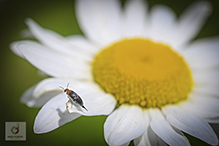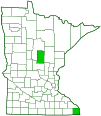cervical tumbling flower beetle
(Mordellistena cervicalis)
Conservation • Description • Habitat • Ecology • Distribution • Taxonomy
Conservation Status |
|
|||||||
| IUCN Red List | not listed |
|||||||
| NatureServe | NNR - Unranked |
|||||||
| Minnesota | not listed |
|||||||
Description |
||
Cervical tumbling flower beetle is a very common small beetle. It occurs in North America from Prince Edward Island to Florida, west to South Dakota and Texas, and in Mexico. It is uncommon in Minnesota. It is often misidentified as Mordellistena comata, but that species is restricted to Mexico and the southern half of the United States. Adults are found on many species of flowers, including common yarrow and fleabane. Larvae develop in plant stems. Adults are wedge-shaped. They are more or less arched and appear humpbacked when viewed from the side. Females are 3⁄16″ (4.75 mm) in length including the style. Males are smaller, ⅛″ (3.0 mm) in length. The head is short, bent downward, and orange. The compound eyes are large, black, and hairy. They extend to the back of the head. The antennae are short, are saw-toothed (serrate), and have eleven segments. The first four segments are pale, the remainder black. The mouthparts are directed downward. The finger-like sensory mouthparts (palps) are pale. The plate on the upper side of the thorax (pronotum) is small, slightly wider than long, and narrowed in front. It is covered with fine gray hairs. It is mostly orange with a dark spot in the middle and dark rear angles. The spot is sometimes diffuse and cloud-like. The plate between the wing bases (scutellum) is triangular and small but visible. The abdomen is long, narrow, and pointed at the end. The wing covers (elytra) are smooth and are covered with fine gray hairs. They are entirely black without any silvery or colored spots or lines. The sides are parallel for most of their length, then narrow toward the rear. There is a distinct, long, pointed process (style) at the tip of the abdomen that extends well beyond the elytra. The style is black and has silvery hairs at the base. The underside of the abdomen is black. The hind legs are long. On the male the front and middle legs are pale, the hind legs are black. On the female all of the legs are black. The third segment (femur) on the hind leg is large. On the front and middle legs, the last part of the leg (tarsus), corresponding to the foot, has 5 segments. On the hind leg the tarsus has just 4 segments. On all legs the claws at the tip of the tarsus are toothed. On all beetles in the subfamily Mordellinae, there are distinct ridges on the hind leg on the outer surface of the fourth segment (tibia) and the first two tarsi. The number, shape, and orientation of the ridges are helpful in identifying the tribe, the genus, and the 955 species of Mordellistena. On Mordellistena cervicalis the hind tibia has two oblique ridges on the outer face, no subapical ridge, and a ridge at the tip. The first tarsal segment has three or four ridges. The second tarsal segment has two ridges. |
||
Size |
||
Female: 3⁄16″ (4.75 mm) Male: ⅛″ (3.0 mm) |
||
Similar Species |
||
Habitat |
||
|
||
Ecology |
||
Season |
||
|
||
Behavior |
||
When threatened, the beetle may rapidly take flight, or it may kick its legs back and forth, causing it to tumble unpredictably. This is the feature that gives the family Mordellidae the common name tumbling flower beetles. |
||
Life Cycle |
||
|
||
Larva Food |
||
Larvae feed within the stems of plants that may be different species than the plants that the adults feed on. |
||
Adult Food |
||
Pollen and nectar of a variety of plant species, including common yarrow and fleabane. |
||
Distribution |
||||
|
Sources |
|||
| 6/27/2022 | ||||
Occurrence |
||||
Uncommon in Minnesota |
||||
Taxonomy |
|||
Order |
Coleoptera (Beetles) | ||
Suborder |
Polyphaga (Water, Rove, Scarab, Long-horned, Leaf, and Snout Beetles) | ||
Infraorder |
Cucujiformia | ||
Superfamily |
Tenebrionoidea (darkling beetles and allies) | ||
Family |
Mordellidae (tumbling flower beetles) | ||
Subfamily |
Mordellinae | ||
Tribe |
Mordellistenini | ||
Genus |
Mordellistena | ||
Synonyms |
|||
|
|||
Common Names |
|||
cervical tumbling flower beetle |
|||
Glossary
Elytra
The hardened or leathery forewings of beetles used to protect the fragile hindwings, which are used for flying. Singular: elytron.
Femur
On insects and arachnids, the third, largest, most robust segment of the leg, coming immediately before the tibia. On humans, the thigh bone.
Palp
Short for pedipalp. A segmented, finger-like process of an arthropod; one is attached to each maxilla and two are attached to the labium. They function as sense organs in spiders and insects, and as weapons in scorpions. Plural: palpi or palps.
Pronotum
The exoskeletal plate on the upper side of the first segment of the thorax of an insect.
Scutellum
The exoskeletal plate covering the rearward (posterior) part of the middle segment of the thorax in some insects. In Coleoptera, Hemiptera, and Homoptera, the dorsal, often triangular plate behind the pronotum and between the bases of the front wings. In Diptera, the exoskeletal plate between the abdomen and the thorax.
Tarsus
On insects, the last two to five subdivisions of the leg, attached to the tibia; the foot. On spiders, the last segment of the leg. Plural: tarsi.
Tibia
The fourth segment of an insect leg, after the femur and before the tarsus (foot). The fifth segment of a spider leg or palp. Plural: tibiae.
Visitor Photos |
|||||
Share your photo of this insect. |
|||||
| This button not working for you? Simply email us at info@MinnesotaSeasons.com. Attach one or more photos and, if you like, a caption. |
|||||
Mike Poeppe |
|||||
 |
|||||
MinnesotaSeasons.com Photos |
|||||
|
|||||

Slideshows |
||

Visitor Videos |
|||
Share your video of this insect. |
|||
| This button not working for you? Simply email us at info@MinnesotaSeasons.com. Attach a video, a YouTube link, or a cloud storage link. |
|||
Other Videos |
|||

Created: 6/27/2022
Last Updated:


